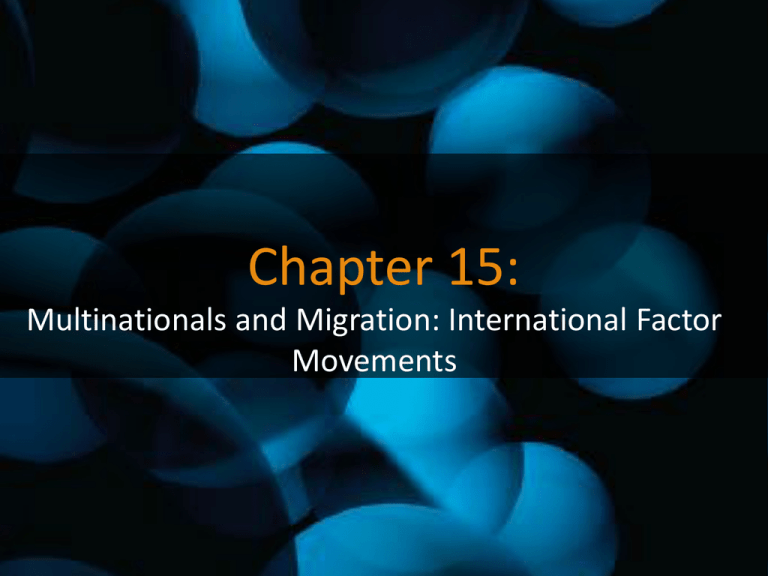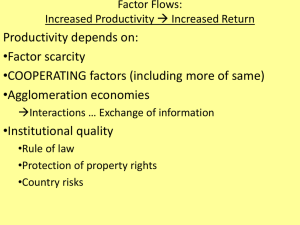
Chapter 15:
Multinationals and Migration: International Factor
Movements
Foreign Direct Investment (FDI)
• Funding provided by investors (usually firms) to
establish or acquire foreign companies or to expand
or finance existing foreign companies that the
investors own.
• Key is sufficient ownership to control or influence
the management of the foreign company. The
agreed international standard is at least 10 percent
ownership.
© 2016 McGraw-Hill Education. All Rights Reserved.
2
Foreign Direct Investments and
Portfolio Investments
© 2016 McGraw-Hill Education. All Rights Reserved.
3
Multinational Enterprises (MNE)
• A firm that owns and controls operations in
more than one country.
• The parent firm of the MNE is located in the
home country. The home country is the
source country for outward FDI.
• The MNE has one or more affiliates located in
one or more host countries. The host country
is the destination country for inward FDI.
© 2016 McGraw-Hill Education. All Rights Reserved.
4
FDI: Flows and Stocks
• Flows of FDI measure new equity investments
and loans within MNEs during a period of time
• Stocks of FDI measure the total amount of
direct investments that exist at a point in time
© 2016 McGraw-Hill Education. All Rights Reserved.
5
Major Home Countries’ Direct Investment
Stocks, End of 2011 (Billions of Dollars)
© 2016 McGraw-Hill Education. All Rights Reserved.
6
Why Do Multinational Enterprises (MNEs) Exist?
• Inherent disadvantages of operating a foreign
affiliate competing against local firms.
• Firm-specific advantages of the MNE,
especially intangible assets.
• Location factors based on resource costs and
availability, customer demand, government
policies, and other considerations.
• Internalization advantages in using these
assets.
• Oligopolistic rivalry that uses FDI in the firms’
strategies for competing.
© 2016 McGraw-Hill Education. All Rights Reserved.
7
Taxation of MNEs’ Profits
• The profits of MNE’s come from the operations of
the parent firms and their foreign affiliates
• National governments impose taxes on business
profits
– Many tax details. Here is broadly the outcome for most
countries.
– The host-country governments tax the profits of the local
affiliates of the MNEs, and the home-country government
taxes the parent company’s “local” profits earned on its
own activities.
© 2016 McGraw-Hill Education. All Rights Reserved.
8
Taxation of MNEs’ Profits
Because tax rates vary across host countries, and
because global MNEs try to minimize the total
taxes that they pay, two important issues arise:
1. MNEs can shop around among countries and
locate its affiliates in the jurisdictions with
governments offering lower tax rates.
2. MNEs can use transfer pricing to report more
of their profits in low-tax countries, even
though profits were actually made in high-tax
countries.
© 2016 McGraw-Hill Education. All Rights Reserved.
9
Transfer Pricing and After-Tax Global
Profit: A Numerical Example
© 2016 McGraw-Hill Education. All Rights Reserved.
10
MNEs and International Trade
• MNEs are heavily involved in international
trade
• About one-third of the world’s international
trade in goods occurs as intrafirm trade
between units of the MNEs located in
different countries.
• Another one-third of the world’s international
trade involves an MNE as the seller (exporter)
or buyer (importer), trading with other firms.
© 2016 McGraw-Hill Education. All Rights Reserved.
11
MNEs and International Trade
In many industries a firm must find reasonable trade-off
between:
1. Centralizing production in one or a few locations and
exporting to many other countries, to achieve
economies of scale.
2. Spreading production to many host countries where
the buyers are, to reduce transport costs, to avoid
actual or threatened barriers to importing into these
countries, or to gain local marketing advantages.
• There are good reasons to think that FDI and trade
could be substitutes or complements.
• Most studies conclude that FDI, on average, is
somewhat complementary to international trade.
© 2016 McGraw-Hill Education. All Rights Reserved.
12
Should the Home Country Restrict FDI Outflows?
We can identify several key effects:
• The effect on workers and others who provide
inputs into production in the home country.
• The effects on the owners of the MNEs based
on this home country
• The effects on the government budget,
especially on government tax revenues
• Any external benefits or costs associated with
direct investment out of the country
© 2016 McGraw-Hill Education. All Rights Reserved.
13
Should the Host Country Restrict FDI Inflows?
1. Standard static analysis of FDI finds
– Workers in the host country gain from increased demand for their
services, as do other suppliers of inputs to the affiliates of foreign
multinationals
– The host country government gains from taxes collected on
affiliate profits, as long as these exceed the extra costs of any
additional government services provided to the affiliates.
– Domestic firms that must compete with the affiliates lose.
– Overall there is a presumption that the host country gains wellbeing in this standard analysis
2. The host country must also weigh indirect economic effects with
respect to incoming FDI, including any positive externalities from FDI
– MNEs bring technology, marketing capabilities, and
managerial skills to the host country.
– While MNE attempts to keep these intangible assets to itself,
some of them do spillover to local firms.
© 2016 McGraw-Hill Education. All Rights Reserved.
14
Migration
• International migration is the movement of
people from one country (the sending
country) to another country (the receiving
country) in which they plan to reside for some
noticeable period of time.
• International migration has played an
enormous role in the past expansion of
receiving countries.
© 2016 McGraw-Hill Education. All Rights Reserved.
15
Gross Immigration Rates into the U.S.,
1820-2012, and Canada, 1852-2012
© 2016 McGraw-Hill Education. All Rights Reserved.
16
Net Immigration Rates into the
European Union, 1960-2012
© 2016 McGraw-Hill Education. All Rights Reserved.
17
How Migration Affects Labor Markets
• Freer migration makes wage rates in the migrantrelated occupations more equal between
countries
• Directly competing workers in the receiving
countries have their pay lowered, relative to less
immigrant-threatened occupations and relative
to such nonlabor incomes as land rents
• Immigrants’ earnings catch up partly, within their
own lifetimes
• World output is raised by allowing more
immigration
© 2016 McGraw-Hill Education. All Rights Reserved.
18
Labor-Market Effects of Migration
© 2016 McGraw-Hill Education. All Rights Reserved.
19
Should the Sending Country Restrict
Emigration?
• The standard economic analysis shows that the
sending country loses national well-being.
• The effects on the sending-country government
budget:
– The sending-country government loses the future tax
payments that the emigrants would have made
– Those who emigrate no longer require government goods,
services, and public assistance, so government spending
goes down
• The sending country benefits from remittances sent
home by emigrants.
© 2016 McGraw-Hill Education. All Rights Reserved.
20
Should the Receiving Country Restrict
Immigration?
• The standard economic analysis shows that the
receiving country gains national well-being
• Effects on the government budget
– Government tax and other revenues
– Government spending
• External costs and benefits
– Knowledge benefits
– Congestion costs
– Social friction
• A net benefit is more likely if the immigrant is a
young adult, better educated, in better health.
© 2016 McGraw-Hill Education. All Rights Reserved.
21





